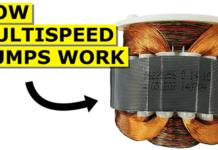Learn how RTD Resistance Temperature Detector sensors work in this article on RTD sensors basics.
Scroll to the bottom to watch the YouTube tutorial.
RTD stands for resistance temperature detector. This is also a fairly simple design. It’s probably easier to understand than the thermocouple. They usually come in these different designs for engineering applications with a rugged casing. How do these work? Well, we know that electricity is the flow of electrons in a circuit.
We have covered how electricity works in detail in our previous article HERE.
When we pass electricity through a material, let’s say a copper wire, the material will have some resistance to the flow of electrons, and we can measure this resistance with a multimeter. Different materials will have different resistance levels.
For example, this one metre length of copper wire shows a very low resistance of just 0.2 ohms. But this one metre length of nickel Chrome wire shows a very high resistance of 22.1 ohms. The temperature of the material will change the resistance of the material. Most conductors will increase in resistance the hotter they get. That’s typical of metals. For example, this copper wire shows a resistance of 0.1 ohms at ambient temperature. But when heated with a flame, it increases up to 0.9 ohms. This occurs because as the atoms and the molecules become excited, they’re going to move around a lot. This makes it harder for the free electrons to get through without a collision.
Using a formula known as Ohm’s law, voltage is equal to current multiplied by resistance, which means that as long as we keep the current the same, a change in resistance will cause a change in voltage. And as temperature changes the resistance of a material, we can measure the voltage to tell the temperature. We use material such as platinum because it has a near linear resistance versus temperature gradient. We test the material at known temperatures to obtain the graph. For example, at zero degrees Celsius, the material will have a resistance of 100 ohms, and at 100 degrees Celsius, it has a resistance of 138.5 ohms.
There are many different designs for this type, but typically they’re either a film type where the platinum is coated into a ceramic plate into a pattern and sealed in glass. Or it will be a platinum wire, wound around a ceramic core again, sealed in glass for protection.


















